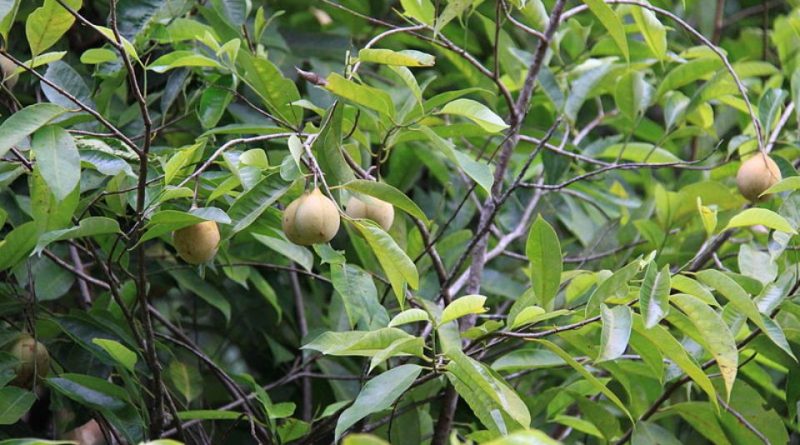Myristica fragrans
Myristica fragrans
The Nutmeg (Myristica fragrans Houtt., 1774) is an arboreal species belonging to the Myristicaceae family.
Systematics –
From a systematic point of view it belongs to the Eukaryota Domain, Kingdom Plantae, Magnoliophyta Division, Magnoliopsida Class, Magnoliales Order, Myristicaceae Family and therefore to the Myristic Genus and to the M. fragrans Species.
Etymology –
The term Myristica comes from the Greek μύρον myron, balsam, fragrant oil, ointment. The specific epithet fragrans derives from fragrant odor, perfume: fragrant, odorous, fragrant.
Geographic Distribution and Habitat –
Myristica fragrans is a tropical tree species with origins in the Moluccas islands and some islands of New Guinea; it is also cultivated in other tropical countries, but the main production area is the Banda Islands in the Moluccas archipelago.
Description –
The Myristica fragrans is an evergreen, dioecious tree, which reaches 8-10 meters with flowering all year round. The leaves are oval, pointed, dark green, with a glossy and waxy upper page. It has small, bell-shaped, fleshy flowers, with the feminine ones in small axillary racemes and the single male ones. Two or three times a year produces numerous fruits, like small peaches with green coloring that, when ripe, become yellow; these fruits are juicy and are used to prepare jams; when they reach maturity they open in half, revealing a walnut that is covered by a bright red aril. Inside this nut (nutmeg) there is only one seed, soft, which however soon becomes of woody consistency.
Cultivation –
Myristica fragrans is a plant that can be grown only in tropical climates. It reaches the age of production towards the eighth year and full production towards the twentieth year. It reproduces both by seed but more frequently by vegetative means (cuttings), which is preferred because it is possible to propagate in a controlled manner the female specimens (which produce the nuts) alternating with the male ones. For the cultivation technique, the following sheet can be consulted.
Uses and Traditions –
Myristica fragrans are marketed, parts of the fruits, as spices: the decorticated seed is nutmeg, while the outer part that covers it supplies the mace.
It also has therapeutic properties so much that at the beginning of the eighteenth century, for its characteristics of antiseptic was considered as a remedy for over one hundred diseases. It reduces nausea, vomiting and diarrhea, while butter is effective for external use against rheumatic and neuralgic pains. It also improves digestion, increases intestinal peristaltic movements and promotes bile flow.
Furthermore, it is recalled that with high dosages it has an amazing-like effect, causing hallucinations and convulsions.
Moreover, although in the culinary field it is used in small quantities, in the past it was used in high doses, especially as an abortifacient; in fact, if it is consumed in high doses, it inhibits the production of prostaglandins that can influence the development of the fetus. Furthermore, the blockage in the synthesis of prostaglandins with topical applications in the scalp plays a role in preventing hair loss.
The main active ingredients of Myristica fragrans are: myristicine, elemicin and safrole.
Preparation Mode –
Nutmeg can be found in whole seeds, dark brown or white (bleached) or ground. For the best maintenance of its properties it is advisable to buy whole seeds, store them in an airtight container and grate them at the time of use. This allows you to better preserve its aroma which, in moderate quantities, is pleasant, warm, spicy and exotic.
This spice has long been used in the kitchen as an ingredient in desserts, puddings and creams and also in the bechamel sauce, mashed potatoes and boiled vegetables. In Italian cuisine, it is also added to fillings, for tortellini, ravioli and cannelloni made with meat, cheese or spinach.
The mace, however, with a more delicate flavor of nutmeg, is used in the kitchen for savory dishes composed of light and bright color, yellow or orange, similar to saffron, as well as in the preparation of spice mixtures (for example curry) , in spicy vinegars, for the preservation of vegetables or in the preparation of home liqueurs such as walnut. It is pleasant in fresh cheese and grated sauces.
Guido Bissanti
Sources
– Acta Plantarum – Flora of the Italian Regions.
– Wikipedia, the free encyclopedia.
– Treben M., 2000. Health from the Pharmacy of the Lord, Advice and experience with medicinal herbs, Ennsthaler Publisher
– Pignatti S., 1982. Flora of Italy, Edagricole, Bologna.
– Conti F., Abbate G., Alessandrini A., Blasi C. (edited by), 2005. An annotated checklist of the Italian vascular flora, Palombi Editore.
Warning: Pharmaceutical applications and alimurgical uses are indicated for informational purposes only and do not in any way represent a medical prescription; there is therefore no liability for their use for curative, aesthetic or food purposes.


